Direct-Write Dewetting of High Melting Temperature Metals on Flexible Substrates
Abstract
:Featured Application
Abstract
1. Introduction
2. Materials and Methods
3. Results
3.1. Directed-Dewetting of Ni and Ag on Par-C Substrates
3.1.1. Nickel
3.1.2. Silver
3.2. Complex Pattern Direct Dewetting of Ni and Ag Films
4. Discussion
5. Conclusions
Supplementary Materials
Author Contributions
Funding
Acknowledgments
Conflicts of Interest
References
- Krishna, H.; Sachan, R.; Strader, J.; Favazza, C.; Khenner, M.; Kalyanaraman, R. Thickness-Dependent Spontaneous Dewetting Morphology of Ultrathin Ag Films. Nanotechnology 2010, 21, 155601. [Google Scholar] [CrossRef] [PubMed]
- Xie, R. Spinodal Dewetting of Thin Polymer Films. Phys. Rev. Lett. 1998, 81, 1251–1254. [Google Scholar] [CrossRef] [Green Version]
- Favazza, C.; Kalyanaraman, R.; Sureshkumar, R. Robust Nanopatterning by Laser-Induced Dewetting of Metal Nanofilms. Nanotechnology 2006, 17, 4229–4234. [Google Scholar] [CrossRef] [PubMed]
- Singh, S.P. Spinodal Theory: A Common Rupturing Mechanism in Spinodal Dewetting and Surface Directed Phase Separation (Some Technological Aspects: Spatial Correlations and the Significance of Dipole-Quadrupole Interaction in Spinodal Dewetting). Adv. Condens. Matter Phys. 2011, 2011, 526397. [Google Scholar] [CrossRef]
- Cavallini, M.; Biscarini, F.; Léon, S.; Zerbetto, F.; Bottari, G.; Leigh, D.A. Information Storage Using Supramolecular Surface Patterns. Science 2003, 299, 531. [Google Scholar] [CrossRef] [PubMed]
- Ghezzi, M.; Thickett, S.C.; Neto, C. Early and Intermediate Stages of Guided Dewetting in Polystyrene Thin Films. Langmuir 2012, 28, 10147–10151. [Google Scholar] [CrossRef] [PubMed]
- Cavallini, M.; Gentili, D.; Greco, P.; Valle, F.; Biscarini, F. Micro- and Nanopatterning by Lithographically Controlled Wetting. Nat. Protoc. 2012, 7, 1668–1676. [Google Scholar] [CrossRef]
- Bystrenova, E.; Facchini, M.; Cavallini, M.; Cacace, M.G.; Biscarini, F. Multiple Length-Scale Patterning of DNA by Stamp-Assisted Deposition. Angew. Chem. Int. Ed. 2006, 45, 4779–4782. [Google Scholar] [CrossRef]
- Herz, A.; Wang, D.; Schaaf, P. Dewetting of Au/Ni Bilayer Films on Prepatterned Substrates and the Formation of Arrays of Supersaturated Au-Ni Nanoparticles. J. Vac. Sci. Technol. B 2014, 32, 021802. [Google Scholar] [CrossRef]
- Wang, D.; Ji, R.; Schaaf, P. Formation of Precise 2D Au Particle Arrays via Thermally Induced Dewetting on Pre-Patterned Substrates. Beilstein J. Nanotechnol. 2011, 2, 318–326. [Google Scholar] [CrossRef]
- Sharma, A.; Ruckenstein, E. Energetic Criteria for the Breakup of Liquid Films on Nonwetting Solid Surfaces. J. Colloid Interface Sci. 1990, 137, 433–445. [Google Scholar] [CrossRef]
- Leroy, F.; Borowik, Ł.; Cheynis, F.; Almadori, Y.; Curiotto, S.; Trautmann, M.; Barbé, J.C.; Müller, P. How to Control Solid State Dewetting: A Short Review. Surf. Sci. Rep. 2016, 71, 391–409. [Google Scholar] [CrossRef]
- Kim, D.; Giermann, A.L.; Thompson, C.V. Solid-State Dewetting of Patterned Thin Films. Appl. Phys. Lett. 2009, 95, 251903. [Google Scholar] [CrossRef]
- Ye, J.; Thompson, C.V. Anisotropic Edge Retraction and Hole Growth during Solid-State Dewetting of Single Crystal Nickel Thin Films. Acta Mater. 2011, 59, 582–589. [Google Scholar] [CrossRef]
- Basu, J.; Carter, C.B.; Divakar, R.; Mukherjee, B.; Ravishankar, N. Nanopatterning by Solid-State Dewetting on Reconstructed Ceramic Surfaces. Appl. Phys. Lett. 2009, 94, 171114. [Google Scholar] [CrossRef]
- Fowlkes, J.D.; Kondic, L.; Diez, J.; Wu, Y.; Rack, P.D. Self-Assembly versus Directed Assembly of Nanoparticles via Pulsed Laser Induced Dewetting of Patterned Metal Films. Nano Lett. 2011, 11, 2478–2485. [Google Scholar] [CrossRef]
- Kuznetsov, A.I.; Koch, J.; Chichkov, B.N. Nanostructuring of Thin Gold Films by Femtosecond Lasers. Appl. Phys. A 2009, 94, 221–230. [Google Scholar] [CrossRef]
- Rack, P.D.; Guan, Y.; Fowlkes, J.D.; Melechko, A.V.; Simpson, M.L. Pulsed Laser Dewetting of Patterned Thin Metal Films: A Means of Directed Assembly. Appl. Phys. Lett. 2008, 92, 223108. [Google Scholar] [CrossRef]
- Singer, J.P.; Lin, P.-T.; Kooi, S.E.; Kimerling, L.C.; Michel, J.; Thomas, E.L. Direct-Write Thermocapillary Dewetting of Polymer Thin Films by a Laser-Induced Thermal Gradient. Adv. Mater. 2013, 25, 6100–6105. [Google Scholar] [CrossRef]
- Ferrer, A.J.; Halajko, A.; Amatucci, G.G. Micro-Patterning of Metallic Film Structures Through Direct-Write Dewetting. Adv. Eng. Mater. 2014, 16, 1167–1178. [Google Scholar] [CrossRef]
- Oh, H.; Lee, J.; Seo, M.; Baek, I.U.; Byun, J.Y.; Lee, M. Laser-Induced Dewetting of Metal Thin Films for Template-Free Plasmonic Color Printing. ACS Appl. Mater. Interfaces 2018, 10, 38368–38375. [Google Scholar] [CrossRef]
- Xiao, S.Y.; Che, L.F.; Li, X.X.; Wang, Y.L. A Novel Fabrication Process of MEMS Devices on Polyimide Flexible Substrates. Microelectron. Eng. 2008, 85, 452–457. [Google Scholar] [CrossRef]
- Miyoshi, Y.; Tkeuchi, T.; Saito, T.; Saito, H.; Kudo, H.; Otsuka, K.; Mitsubayashi, K. A Wearable Humidity Sensor with Hydrophilic Membrane by Soft-MEMS Techniques. In Proceedings of the 2007 2nd IEEE International Conference on Nano/Micro Engineered and Molecular Systems, Bangkok, Thailand, 16–19 January 2007; pp. 211–214. [Google Scholar]
- Noh, H.-S.; Huang, Y.; Hesketh, P.J. Parylene Micromolding, a Rapid and Low-Cost Fabrication Method for Parylene Microchannel. Sens. Actuators B Chem. 2004, 102, 78–85. [Google Scholar] [CrossRef]
- Winslow, B.D.; Christensen, M.B.; Yang, W.-K.; Solzbacher, F.; Tresco, P.A. A Comparison of the Tissue Response to Chronically Implanted Parylene-C-Coated and Uncoated Planar Silicon Microelectrode Arrays in Rat Cortex. Biomaterials 2010, 31, 9163–9172. [Google Scholar] [CrossRef]
- Schmidt, E.M.; Mcintosh, J.S.; Bak, M.J. Long-Term Implants of Parylene-C Coated Microelectrodes. Med. Biol. Eng. Comput. 1988, 26, 96–101. [Google Scholar] [CrossRef]
- Lienhard, D.; Heepmann, F.; Ploss, B. Thin Nickel Films as Absorbers in Pyroelectric Sensor Arrays. Microelectron. Eng. 1995, 29, 101–104. [Google Scholar] [CrossRef]
- Choi, J.W.; Sung, W. A Planar and Membraneless Microscale Fuel Cell Using Nickel and Silver as Catalysts. In Proceedings of the 13th International Conference on Solid-State Sensors, Actuators and Microsystems, Seoul, Korea, 5–9 June 2005; Digest of Technical Papers. Transducers ’05. Volume 2, pp. 1852–1855. [Google Scholar]
- Weissler, G.L.; Carlson, R.W. (Eds.) Vacuum Physics and Technology; Methods of Experimental Physics; Academic Press: New York, NY, USA, 1979. [Google Scholar]
- Rhee, S.K. Surface Energies of Silicate Glasses Calculated from Their Wettability Data. J. Mater. Sci. 1977, 12, 823–824. [Google Scholar] [CrossRef]
- Gussarov, A.I.; Doyle, D.B.; Glebov, L.B.; Berghmans, F. Radiation-Induced Transmission Degradation of Borosilicate Crown Optical Glass from Four Different Manufacturers. Opt. Eng. 2007, 46, 043004. [Google Scholar] [CrossRef]
- Tan, C.P.; Craighead, H.G. Surface Engineering and Patterning Using Parylene for Biological Applications. Materials 2010, 3, 1803–1832. [Google Scholar] [CrossRef] [Green Version]
- Jeong, Y.S.; Ratier, B.; Moliton, A.; Guyard, L. UV–Visible and Infrared Characterization of Poly(p-Xylylene) Films for Waveguide Applications and OLED Encapsulation. Synth. Met. 2002, 127, 189–193. [Google Scholar] [CrossRef]
- French, R.H.; Rodríguez-Parada, J.M.; Yang, M.K.; Derryberry, R.A.; Lemon, M.F.; Brown, M.J.; Haeger, C.R.; Samuels, S.L.; Romano, E.C.; Richardson, R.E. Optical Properties of Materials for Concentrator Photovoltaic Systems. In Proceedings of the 2009 34th IEEE Photovoltaic Specialists Conference (PVSC), Philadelphia, PA, USA, 7–12 June 2009; pp. 000394–000399. [Google Scholar] [CrossRef]
- Haynes, W.M. CRC Handbook of Chemistry and Physics: A Ready-Reference Book of Chemical and Physical Data; CRC Press: London, UK; New York, NY, USA; Boca Raton, FL, USA, 2014. [Google Scholar]
- Tyson, W.R.; Miller, W.A. Surface Free Energies of Solid Metals: Estimation from Liquid Surface Tension Measurements. Surf. Sci. 1977, 62, 267–276. [Google Scholar] [CrossRef]
- Wyart, F.B.; Daillant, J. Drying of Solids Wetted by Thin Liquid Films. Can. J. Phys. 2011, 68, 1084–1088. [Google Scholar] [CrossRef]
- Mills, A.A.; Fry, J.D. Rate of Evaporation of Hydrocarbons from a Hot Surface: Nukiyama and Leidenfrost Temperatures. Eur. J. Phys. 1982, 3, 152–154. [Google Scholar] [CrossRef]
- Choi, S.-H.; Zhang Newby, B. Dynamic Contact Angle in Rim Instability of Dewetting Holes. J. Chem. Phys. 2006, 124, 054702. [Google Scholar] [CrossRef]
- Brochard-Wyart, F.; Redon, C. Dynamics of Liquid Rim Instabilities. Langmuir 1992, 8, 2324–2329. [Google Scholar] [CrossRef]
- Sekimot, K.; Oguma, R.; Kawasaki, K. Morphological Stability Analysis of Partial Wetting. Ann. Phys. 1987, 176, 359–392. [Google Scholar] [CrossRef]
- Thomy, C.; Seefeld, T.; Vollertsen, F. The Occurrence of Humping in Welding with Highest Beam Qualities. In Key Engineering Materials; Trans Tech Publications: Zurich, Switzerland, 2007; Volume 344, pp. 731–743. [Google Scholar] [CrossRef]
- Karakaya, I.; Thompson, W.T. The Ag-Bi (Silver-Bismuth) System. J. Phase Equilib. 1993, 14, 525–530. [Google Scholar] [CrossRef]
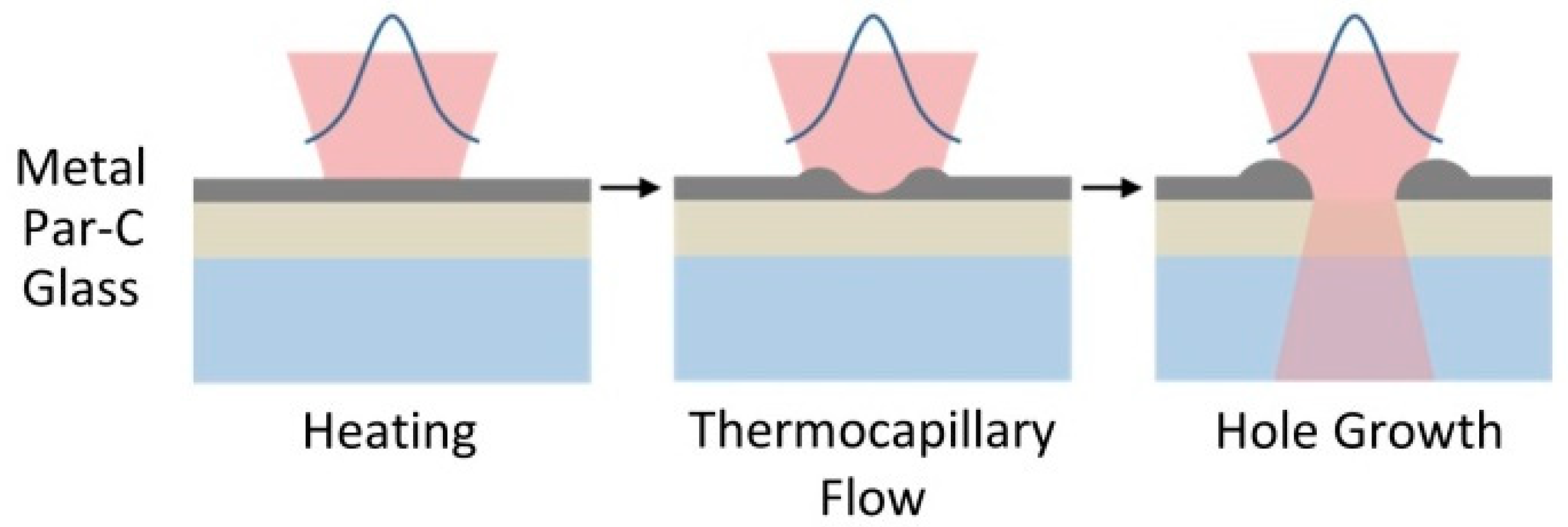

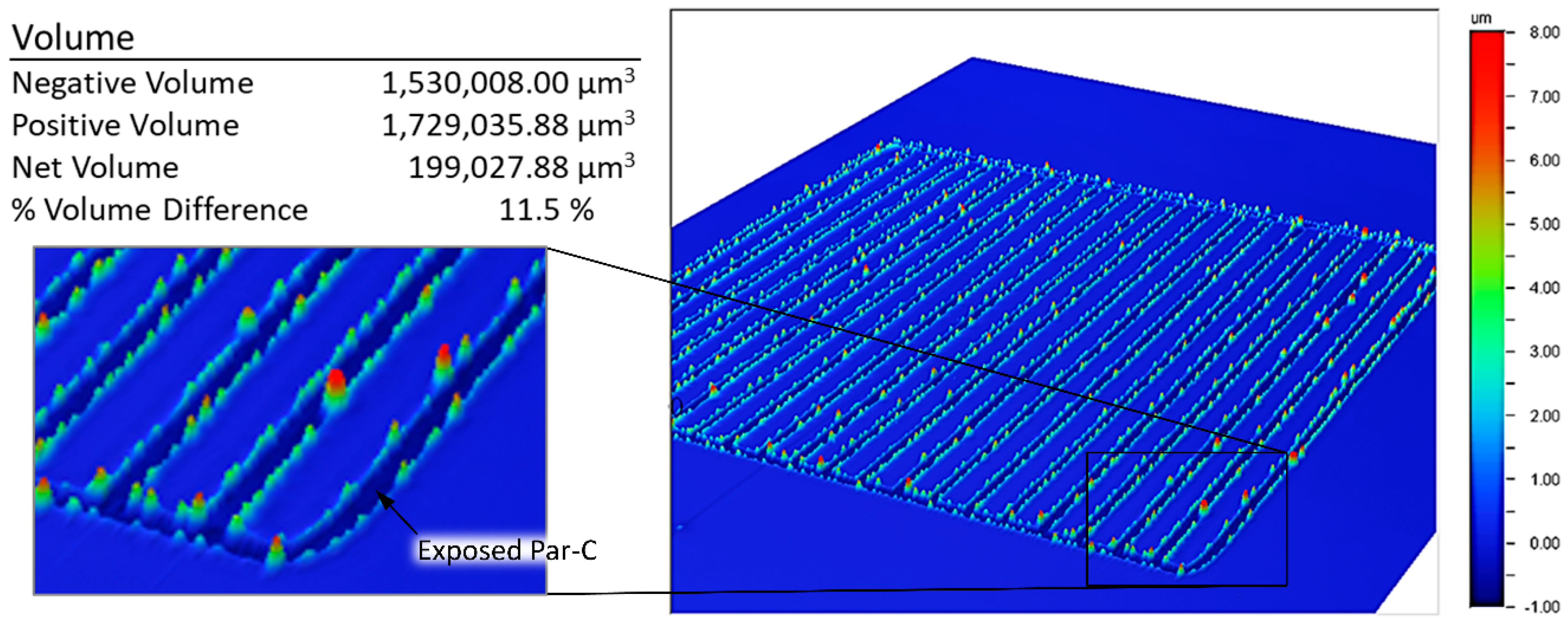
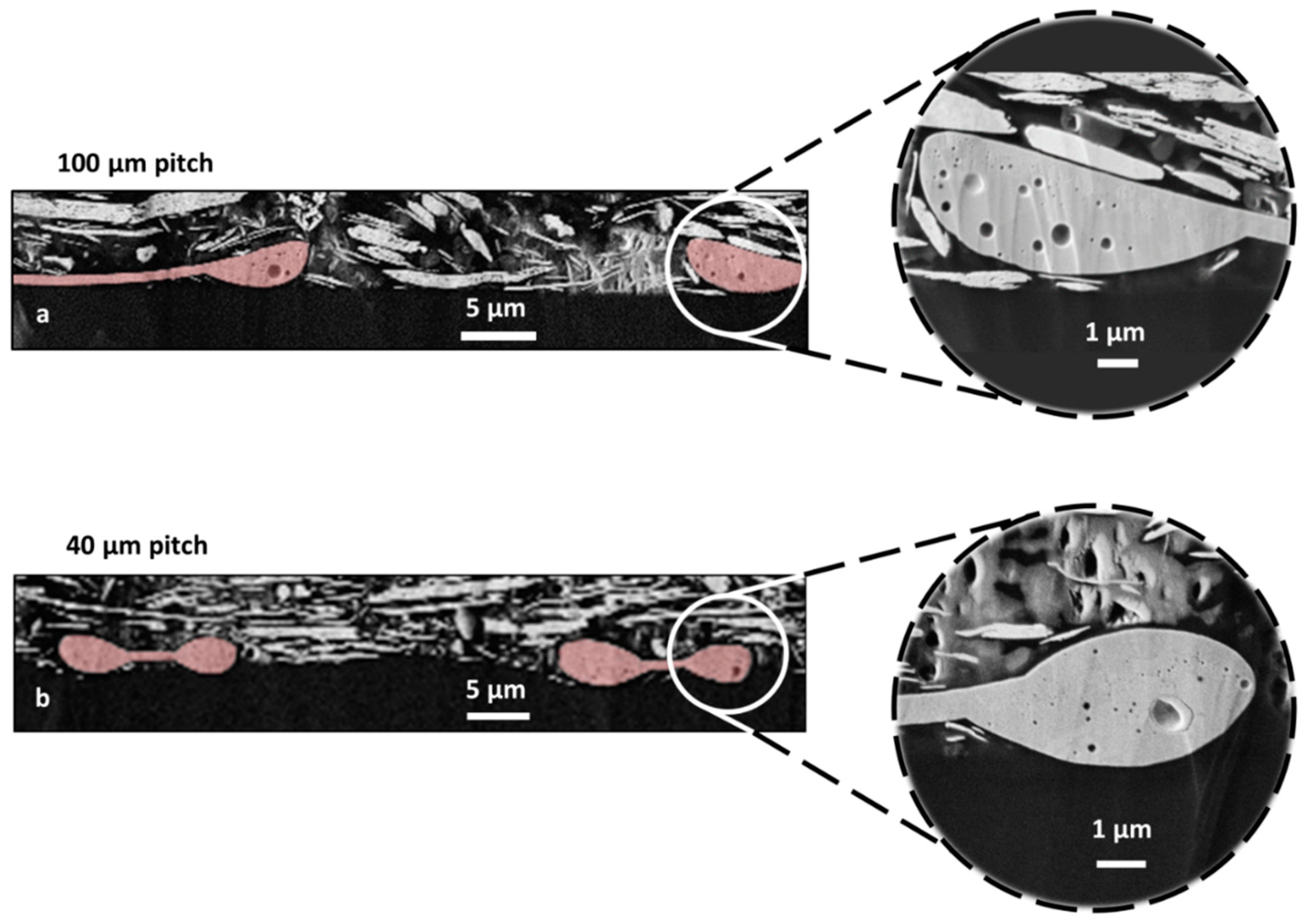




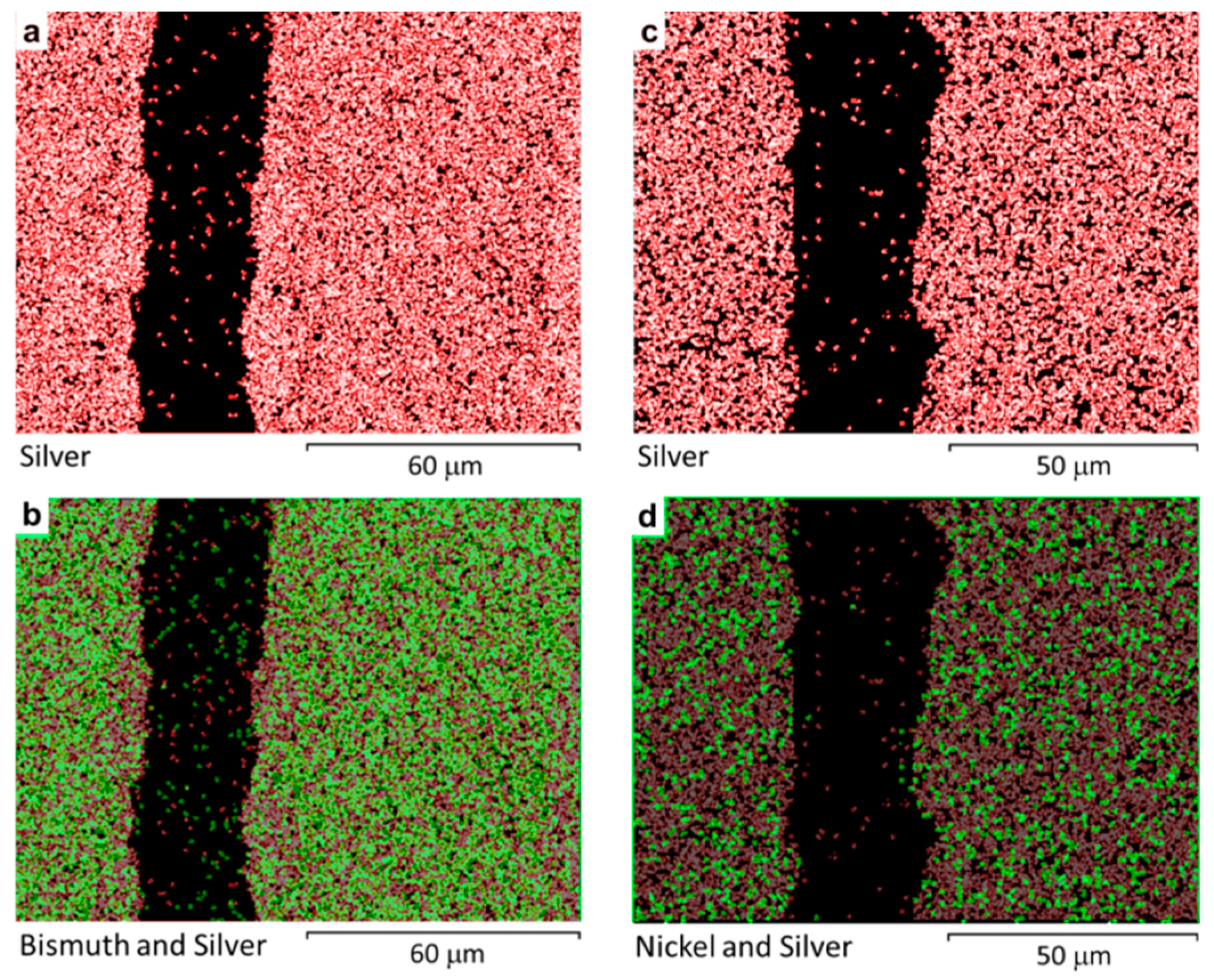
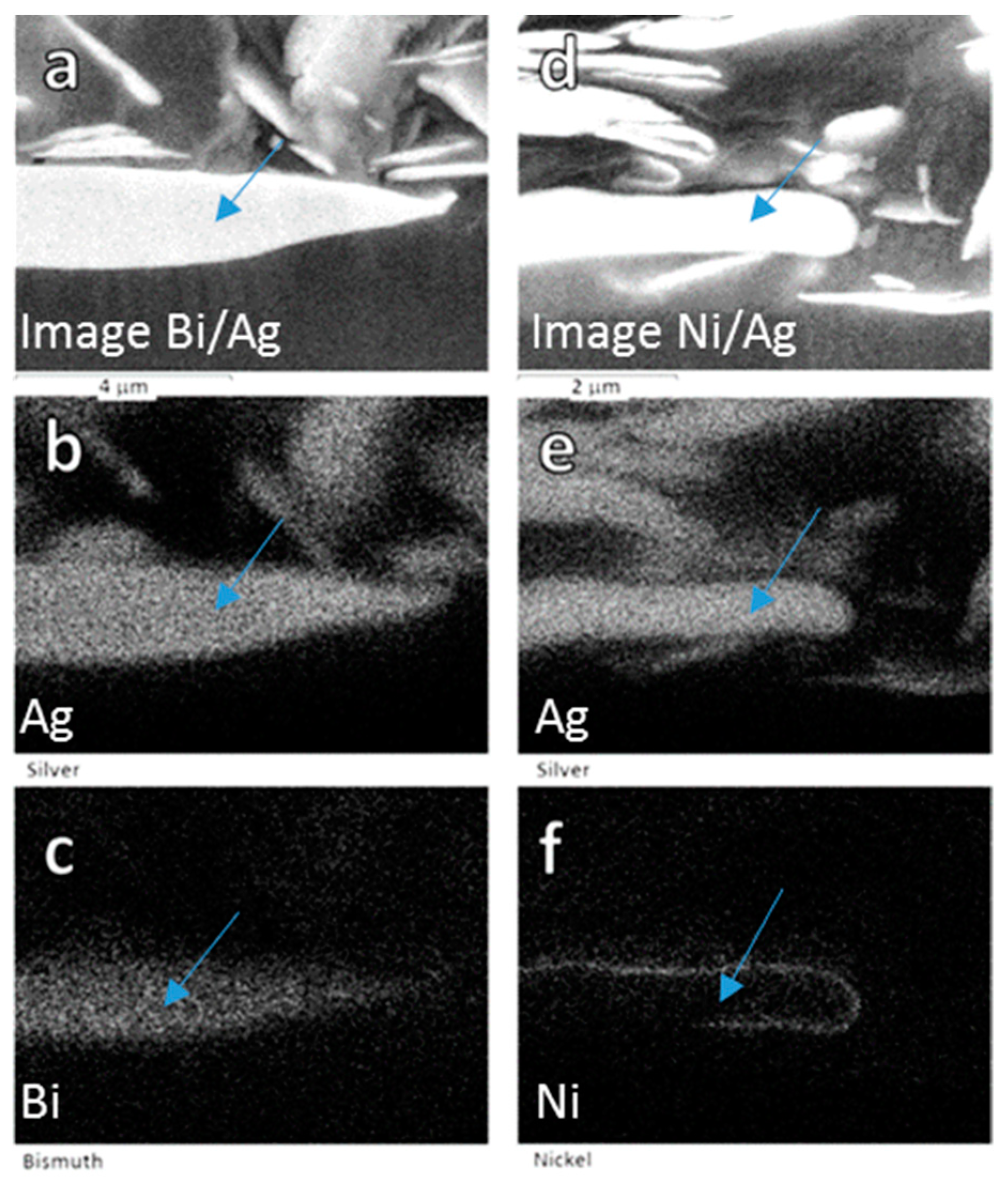


| Material | M.P. | Surface Energy/Tension [mJ/m2] | Inherent Absorptivity at 1064 nm [%] | Thermal Conductivity [W/(m∙K)] | Electrical Resistivity [Ω∙m] | |
|---|---|---|---|---|---|---|
| Solid | Liquid | |||||
| Borosilicate Glass | 821 [29] (soften) | 253.0 [30] | - | < 3 [31] | 1.05 | 8 × 108 |
| Parylene-C | 290 [32] | 19.6 [32] | - | < 15 [33] | 0.082 | 1 × 1015 |
| Polyimide | 400 (soften) | 53 | - | < 10 [34] | 0.15 | 1.5 × 1015 |
| PTFE | 327 | 20 | - | < 10 [34] | 0.26 [35] | 1 × 1023 |
| Bi | 271.5 [35] | 446 [36] | 378 [36] | 32 1 | 7.87 [35] | 107 × 10−8 [35] |
| Sn | 231.93 [35] | 661 [36] | 560 [36] | 54 1 | 66.6 [35] | 11.5 × 10−8 [35] |
| Ni | 1455 [35] | 2080 [36] | 1763 [36] | 28 1 | 90.7 [35] | 6.93 × 10−8 [35] |
| Ag | 962 [35] | 1086 [36] | 920 [36] | < 5 1 | 429 [35] | 1.587 × 10−8 [35] |
© 2019 by the authors. Licensee MDPI, Basel, Switzerland. This article is an open access article distributed under the terms and conditions of the Creative Commons Attribution (CC BY) license (http://creativecommons.org/licenses/by/4.0/).
Share and Cite
Ferrer, A.J.; Halajko, A.; Amatucci, G.G. Direct-Write Dewetting of High Melting Temperature Metals on Flexible Substrates. Appl. Sci. 2019, 9, 3165. https://doi.org/10.3390/app9153165
Ferrer AJ, Halajko A, Amatucci GG. Direct-Write Dewetting of High Melting Temperature Metals on Flexible Substrates. Applied Sciences. 2019; 9(15):3165. https://doi.org/10.3390/app9153165
Chicago/Turabian StyleFerrer, Anthony J., Anna Halajko, and Glenn G. Amatucci. 2019. "Direct-Write Dewetting of High Melting Temperature Metals on Flexible Substrates" Applied Sciences 9, no. 15: 3165. https://doi.org/10.3390/app9153165





